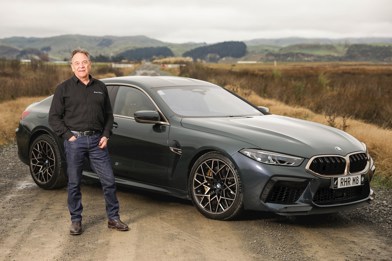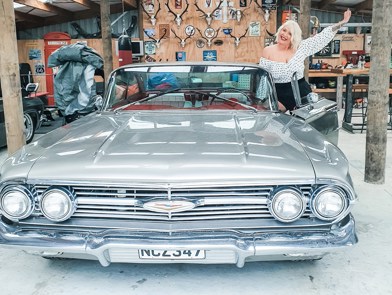Living in the shadow of big brother can be a challenge: think Ralf Schumacher, Liam Hemsworth or one of Beauden Barrett’s brothers whom we can’t name because we don’t watch rugby.
It’s a little like that with this Land Rover Discover Sport P250 Dynamic SE, updated for 2024 with a more modern luxury interior, latest tech and added functionality. In the Land Rover/Range Rover family, it’s the smallest, youngest sibling, and starts at $101,000, which is also $8k less than even the Range Rover Evoque; but it has a reputation of its siblings to live up to.

At a glance, the Disco Sport could be easily mistaken for a normal Discovery, something that covets another $50k/50 per cent premium over the Sport.
Think of it as a way to "discover" the brand, and while $101,000 might not be entry level to everybody, it’s value-for-money that counts.
The Discovery is a family oriented premium adventure SUV, with the ability to go off-roading and/or tow. It’s been that way for nine years since its local launch.

And while it might be the entry level model of the Land Rover brand, it’s certainly not entry level equipment.
Biggest attention-getter and new for 2024 is a floating 11.4-inch curved glass Pivi Pro1 touchscreen that’s, to quote Land Rover, “packed with infotainment features”. That’s an understatement, as the 2024 interior and dash is so clean, you wonder where all the buttons have gone. Aside from the shifter, wireless phone charger pocket, felt-lined flip-up cubby and the two USB-ports (five in total), the front seats are largely void of any commonly used buttons, which is both fantastic and, at times, infuriating.

It puts all the controls onto the touchscreen, with the ‘home’ page offering shortcuts on either side to key functions for climate and volume, demisting…. navigation, audio, camera… drive mode, phone and personal settings and a home button. Then the main menu page offers all the functionality buttons, including those aforementioned, plus seat options, eco driving data, 4x4 modes, low-traction launch, vehicle dimensions, valet mode, wade sensing up to 600mm… and that’s about half of them. The picture speaks 100 words: it’s a lot to take in and familiarity does help. After a few days, changing a radio station had gone from chore to process. CarPlay and Android are both offered.

Navigation is also a party piece of a Land Rover with various off-road settings. With iAWD (the i for intelligent, naturally), All Terrain Progress Control offers a number of automatic and preset conditions to make off-roading a little more involved, such as bearing, tilt and ramp angles, altitude and hill descent, plus active kit like torque-vectoring for added grip and Land Rover’s Terrain Response 2 system.

Keeping it real for the city, it uses a modest 2.0-litre turbo petrol engine: its power numbers are a garish irrelevance, so we’ll keep them to the tech panel, but it is moderately fast, able to 0-100 in 7.8 seconds, and a reasonable 8.2l/100km. Once motoring along it’s a smooth operator, but the ultimate judge is possibly one merely using it for its function: I gave it to my other half, Arna, a typical target customer and business professional, for a few days for her work, school and sport runs, and the feedback was quite positive.

She quickly got used to the touchscreen, liked the performance but, being the Land Rover/Range Rover brand-fan she is, thought a bit more power would be appropriate, highlighting her champagne taste on her managerial-level sparking white wine budget.
Arna loved the quiet, comfort and safety and tech additions like the auto-dipping high-beam headlights, but also mentioned that low-speed response felt sluggish - and this is certainly sometimes the case, with it taking up to a full two seconds to respond to throttle input, for example, when exiting a roundabout, while it shifts down a few of its nine-speeds, and winds up boost and revs. It’s also a little jerky: subtle but noticeable, at low speeds, low throttle, possibly again shuffling through gears – a few taps on the left shift paddle helps pre-select the right gear in those situations. Not deal-breakers by any means, just observation of idiosyncrasies.

The interior is simply stunning, a beautiful Ebony/Lunar Grey in our test car, with cabin lighting, alloy pedals, heated steering wheel and dual-zone climate control. The adaptive cruise control is superb, with a lengthy stop & go, which is ideal for Auckland traffic, and it can also revert to standard cruise - though it needs a specific button press to activate.
The dash display is classically stylish but modern, with a traditional, clean, dial style, all done digitally.

Which brings us to the Disco’s biggest irritation, the driver alert warnings. First things both wifey and I adapted to do after entering the car was the start button, seat-belt, and hold the settings button on the steering wheel to change the driver alter warnings from high to low. Otherwise, insanity is just a few speed sign changes and incessant beeping away.

Practicality is also high, and though the 11.8m turning circle is on the large side, meaning ghastly three-point turns at the school drops-offs, there is a lot of very good and smart features, like Isofix mounting points on the front seats, front and rear parking aids, rear traffic monitor, and autonomous emergency braking.

Our car was also fitted with a few options, of the many available, including a $1500 detachable towing pack, a $2700 panoramic roof, $1950 Meridian Surround Sound system, and a Surround Camera with Wade Sending for $1500. With many optional 19, 20 and 21in wheels, a third-row seven seating ($3200), tailored option packs or single optional features, it’s very easy to spend a lot more on the entry level Discovery.

So, Discovery doesn’t actually live in its siblings shadows, it’s every bit as good for its price and offerings. In sibling speak, you could almost call it the Tim Finn... or the similarly talented Neil.
BREAK IT DOWN
Discovery Sport P250 Dynamic SE
ENGINE: 2.0 turbo petrol four
POWER: 184kW/365Nm
GEARBOX: 9-speed auto
ECONOMY: 8.2l/100km
0-100KM/H: 7.8 secs
PRICE: $101,000

























